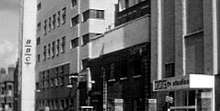Lime Grove Studios
Lime Grove Studios was a film, and later television, studio complex in Shepherd's Bush, West London, England.

The complex was built by the Gaumont Film Company in 1915. It was situated in Lime Grove, a residential street in Shepherd's Bush, and when it first opened was described by Gaumont as "the finest studio in Great Britain and the first building ever put up in this country solely for the production of films". Many Gainsborough Pictures films were made here from the early 1930s. Its sister studio was Islington Studios, also used by Gainsborough; films were often shot partly at Islington and partly at Lime Grove.
In 1949, the complex was purchased by the BBC, who used it for television broadcasts until 1991. It was demolished in 1993.[1]
Gaumont-British Picture Corporation
In 1922, Isidore Ostrer along with brothers Mark and Maurice, acquired control of Gaumont-British from its French parent. In 1932 a major redevelopment of Lime Grove Studios was completed, creating one of the best equipped studio complexes of that era. The first film produced at the remodelled studio was the Walter Forde thriller Rome Express (1932), which became one of the first British sound films to gain critical and financial success in the United States (where it was distributed by Universal Pictures).
The studios prospered under Gaumont-British, and in 1941 were bought by the Rank Organisation. By then Rank had a substantial interest in Gainsborough Pictures, and The Wicked Lady (1945), among other Gainsborough melodramas, was shot at Lime Grove.
BBC studios
In 1949 the BBC bought Lime Grove Studios as a "temporary measure"—because they were to build Television Centre at nearby White City—and began converting them from film to television use, reopening them on 21 May 1950.[2]
Lime Grove would be used for many BBC Television programmes over the next forty-two years, including: Nineteen Eighty-Four; Steptoe and Son; Doctor Who; Nationwide; Top of the Pops; and The Grove Family, which took its title family from the studios, where it was made. A children's magazine-style programme, Studio E, was broadcast live from the studio of the same name from 1955 until 1958; it was hosted by Vera McKechnie.
Lime Grove's use for programmes outside current affairs declined over time, and later episodes of the continuing series were made at BBC Television Centre and BBC Elstree Centre. Indeed, in Lime Grove Studios' final years, its official name was Lime Grove Current Affairs Production Centre. The last live programme was The Late Show on 13 June 1991 from Studio D, although the final portion of the programme, with a symbolic "unplugging" of a camera power cord in Studio D by Cliff Michelmore, was pre-recorded.
Humble Pie performed Desperation, a Steppenwolf single from the debut albums of both: Steppenwolf and Humble Pie; Natural Born Bugie, their debut single; Heartbeat, a Buddy Holly single, and; The Sad Bag of Shaky Jake, their second single, for a recording-and-broadcast for the BBC. Led Zeppelin performed White Summer and Black Mountain Side there, on The Julie Felix Show, on 23 April 1970.
In 1991 the BBC decided to consolidate its London television production at the nearby BBC Television Centre and to close its other studios including Lime Grove. On 26 August 1991, a month after the studios were closed, the BBC transmitted a special day of programming called The Lime Grove Story, featuring examples of the many programmes and films that had been made at Lime Grove in its 76 years as a place of film and television production.[3] BBC Television Theatre close by, near Shepherd's Bush Green, reverted to being the Shepherd's Bush Empire.
By the end, the building was in such a poor state of repair that the remaining BBC staff nicknamed it "Slime Grove". The building was put on the market and eventually bought by a development company, Notting Hill Housing Association, which demolished the studios in 1993, and redeveloped the site into a housing estate. The streets in the estate were named Gaumont Terrace and Gainsborough Court, in memory of the past owners of Lime Grove Studios.
In popular culture
Lime Grove Studios was the setting for the fictional current affairs programme The Hour in the BBC drama of the same name. The studios are also represented in the 2013 drama An Adventure in Space and Time which was shot at Wimbledon Studios.
References
- "The BBC's TV studios in London". tvstudiohistory.co.uk. Archived from the original on 3 June 2007. Retrieved 18 February 2010.
- 1950s British TV Milestones Whirligig 50s British TV
- Radio Times feature on The Lime Grove Story Archived 2004-01-16 at the Wayback Machine Doctor Who Cuttings Archive